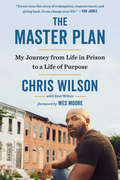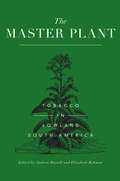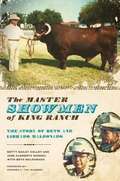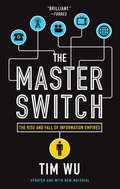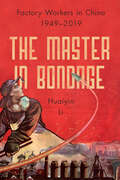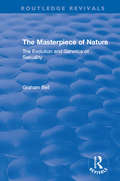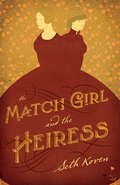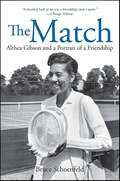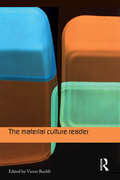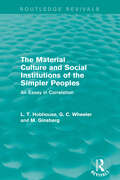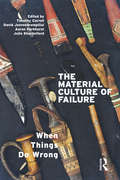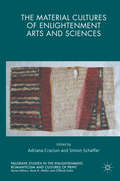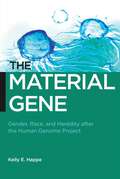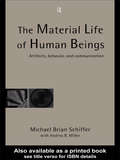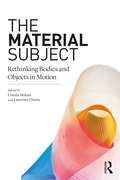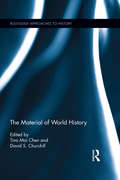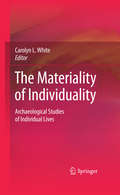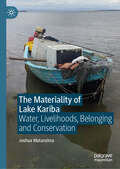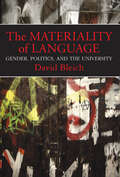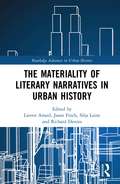- Table View
- List View
The Mass Media and the Dynamics of American Racial Attitudes
by Paul M. KellstedtPaul M. Kellstedt explains the variation in Americans' racial attitudes over the last half-century, particularly the relationship between media coverage of race and American public opinion on race. The analyses reveal that racial policy preferences have evolved in an interesting and unpredicted (if not unpredictable) fashion over the past fifty years. There have been sustained periods of liberalism, where the public prefers an active government to bring about racial equality, and these periods are invariably followed by eras of conservatism, where the public wants the government to stay out of racial politics altogether. These opinions respond to cues presented in the national media. Kellstedt then examines the relationship between attitudes on the two major issues of the twentieth century: race and the welfare state.
The Massachusetts Story
by Gibbs Smith Education"This book contains chapters on: The Land We Call Home, The First People, Pilgrims and Puritans, Massachusetts in the American Revolution, and Your Hometown. "
The Master Plan: My Journey from Life in Prison to a Life of Purpose
by Bret Witter Wes Moore Chris WilsonThe inspiring, instructive, and ultimately triumphant memoir of a man who used hard work and a Master Plan to turn a life sentence into a second chance.Growing up in a tough Washington, D.C., neighborhood, Chris Wilson was so afraid for his life he wouldn't leave the house without a gun. One night, defending himself, he killed a man. At eighteen, he was sentenced to life in prison with no hope of parole.But what should have been the end of his story became the beginning. Deciding to make something of his life, Chris embarked on a journey of self-improvement--reading, working out, learning languages, even starting a business. He wrote his Master Plan: a list of all he expected to accomplish or acquire. He worked his plan every day for years, and in his mid-thirties he did the impossible: he convinced a judge to reduce his sentence and became a free man. Today Chris is a successful social entrepreneur who employs returning citizens; a mentor; and a public speaker. He is the embodiment of second chances, and this is his unforgettable story.
The Master Plant: Tobacco in Lowland South America (Criminal Practice Ser.)
by Andrew RussellDescribed as a ‘master plant’ by many indigenous groups in lowland South America, tobacco is an essential part of shamanic ritual, as well as a source of everyday health, wellbeing and community. In sharp contrast to the condemnation of the tobacco industry and its place in contemporary public health discourse, the book considers tobacco in a more nuanced light, as an agent both of enlightenment and destruction.Exploring the role of tobacco in the lives of indigenous peoples, The Master Plant offers an important and unique contribution to this field of study through its focus on lowland South America: the historical source region of this controversial plant, yet rarely discussed in recent scholarship. The ten chapters in this collection bring together ethnographic accounts, key developments in anthropological theory and emergent public health responses to indigenous tobacco use. Moving from a historical study of tobacco usage – covering the initial domestication of wild varieties and its value as a commodity in colonial times – to an examination of the transcendent properties of tobacco, and the magic, symbolism and healing properties associated with it, the authors present wide-ranging perspectives on the history and cultural significance of this important plant. The final part of the book examines the changing landscape of tobacco use in these communities today, set against the backdrop of the increasing power of the national and transnational tobacco industry.The first critical overview of tobacco and its uses across lowland South America, this book encourages new ways of thinking about the problems of commercially exploited tobacco both within and beyond this source region.
The Master Showmen of King Ranch
by Stephen J. "Tio" KlebergTexas's King Ranch has become legendary for a long list of innovations, the most enduring of which is the development of the first official cattle breed in the Americas, the Santa Gertrudis. Among those who played a crucial role in the breed's success were Librado and Alberto "Beto" Maldonado, master showmen of the King Ranch. A true "bull whisperer," Librado Maldonado developed a method for gentling and training cattle that allowed him and his son Beto to show the Santa Gertrudis to their best advantage at venues ranging from the famous King Ranch auctions to a Chicago television studio to the Dallas-Fort Worth airport. They even boarded a plane with the cattle en route to the International Fair in Casablanca, Morocco, where they introduced the Santa Gertrudis to the African continent. In The Master Showmen of King Ranch, Beto Maldonado recalls an eventful life of training and showing King Ranch Santa Gertrudis. He engagingly describes the process of teaching two-thousand-pound bulls to behave "like gentlemen" in the show ring, as well as the significant logistical challenges of transporting them to various high-profile venues around the world. His reminiscences, which span more than seventy years of King Ranch history, combine with quotes from other Maldonado family members, co-workers, and ranch owners to shed light on many aspects of ranch life, including day-to-day work routines, family relations, women's roles, annual celebrations, and the enduring ties between King Ranch owners and the vaquero families who worked on the ranch through several generations.
The Master Switch: The Rise and Fall of Information Empires
by Tim WuA secret history of the industrial wars behind the rise and fall of the 20th century's great information empires--Hollywood, the broadcast networks, and ATT--asking one big question: Could history repeat itself, with one giant entity taking control of American information?
The Master in Bondage: Factory Workers in China, 1949-2019
by Huaiyin LiDrawing on a rich set of original oral histories conducted with retired factory workers from industrial centers across the country, this book provides a bottom-up examination of working class participation in factory life during socialist and reform-era China. Huaiyin Li offers a series of new interpretations that challenge, revise, and enrich the existing scholarship on factory politics and worker performance during the Maoist years, including the nature of the Maoist state as seen in the operation of power relations on the shop floor, as well as the origins and dynamics of industrial enterprise reforms in the post-Mao era. In sharp contrast with the ideologically driven goal of promoting grassroots democracy or manifesting workers' status as the masters of the workplace, Li argues that Maoist era state-owned enterprises operated effectively to turn factory workers into a well-disciplined labor force through a complex set of formal and informal institutions that functioned to generate an equilibrium in power relations and work norms. The enterprise reforms of the 1980s and 1990s undermined this preexisting equilibrium, catalyzing the transformation of the industrial workforce from predominantly privileged workers in state-owned enterprises to precarious migrant workers of rural origins hired by private firms. Ultimately, this comprehensive and textured history provides an analytically astute new picture of everyday factory life in the world's largest manufacturing powerhouse.
The Masterpiece of Nature: The Evolution and Genetics of Sexuality (Routledge Revivals)
by Graham BellOriginally published in 1982, The Masterpiece of Nature examines sex as representative of the most important challenge to the modern theory of evolution. The book suggests that sex evolved, not as the result of normal Darwinian processes of natural selection, but through competition between populations or species - a hypothesis elsewhere almost universally discredited. The book also discusses the nature of sex and its consequences for the individual and for the population, as well as various other theories of sex. Since the value of these theories is held to reside wholly in their ability to predict the patterns of sexuality observed in nature, the book seeks to provide an extensive review of the circumstances in which sexuality is attenuated or lost throughout the animal kingdom, and these facts are then used to weigh up the merits of the rival theories. This book will be of interest to researchers in the area of genetics, ecology and evolutionary biology.
The Match Girl and the Heiress
by Seth KovenNellie Dowell was a match factory girl in Victorian London who spent her early years consigned to orphanages and hospitals. Muriel Lester, the daughter of a wealthy shipbuilder, longed to be free of the burden of money and possessions. Together, these unlikely soulmates sought to remake the world according to their own utopian vision of Christ's teachings. The Match Girl and the Heiress paints an unforgettable portrait of their late-nineteenth-century girlhoods of wealth and want, and their daring twentieth-century experiments in ethical living in a world torn apart by war, imperialism, and industrial capitalism.In this captivating book, Seth Koven chronicles how each traveled the globe--Nellie as a spinster proletarian laborer, Muriel as a well-heeled tourist and revered Christian peacemaker, anticolonial activist, and humanitarian. Koven vividly describes how their lives crossed in the slums of East London, where they inaugurated a grassroots revolution that took the Sermon on the Mount as a guide to achieving economic and social justice for the dispossessed. Koven shows how they devoted themselves to Kingsley Hall--Gandhi's London home in 1931 and Britain's first "people's house" founded on the Christian principles of social sharing, pacifism, and reconciliation--and sheds light on the intimacies and inequalities of their loving yet complicated relationship.The Match Girl and the Heiress probes the inner lives of these two extraordinary women against the panoramic backdrop of shop-floor labor politics, global capitalism, counterculture spirituality, and pacifist feminism to expose the wounds of poverty and neglect that Christian love could never heal.
The Match: Althea Gibson and a Portrait of a Friendship
by Bruce SchoenfeldThe incredible story of what happened when two outsiders—one an emerging champion who happens to be Jewish, the other, the first black player to win Wimbledon—pair up not only to form a winning team, but also an enduring friendship.Althea Gibson first met Angela Buxton at an exhibition match in India. On the surface, the two women couldn’t be more different. The daughter of sharecroppers and fiercely competitive, Althea Gibson was born in the American South and turned to athletics in an effort to belong to a community that would welcome her. Angela Buxton, the granddaughter of Russian Jews, grew up in Liverpool. England, where her father ran a successful business. But they both faced their share of prejudice, particularly on the tennis circuit, where they were excluded from tournaments and clubs because of race and religion. At the 1956 Wimbledon, despite their athletic prowess, both were shunned by the other female players and found themselves without doubles partners. Undaunted, they decided to play together. And though they had never so much as practiced together—they triumphed. In Nobody’s Darlings, Bruce Schoenfeld delivers an unexpected story of two underdogs who refused to let bigotry stop them both on the court and off. Here too is the story of a remarkable friendship.
The Material Atlantic
by Robert S. DuplessisIn this wide-ranging account, Robert DuPlessis examines globally sourced textiles that by dramatically altering consumer behaviour, helped create new economies and societies in the early modern world. This deeply researched history of cloth and clothing offers new insights into trade patterns, consumer demand and sartorial cultures that emerged across the Atlantic world between the mid-seventeenth and late-eighteenth centuries. As a result of European settlement and the construction of commercial networks stretching across much of the planet, men and women across a wide spectrum of ethnicities, social standings and occupations fashioned their garments from materials old and new, familiar and strange, and novel meanings came to be attached to different fabrics and modes of dress. The Material Atlantic illuminates crucial developments that characterised early modernity, from colonialism and slavery to economic innovation and new forms of social identity.
The Material Culture Reader
by Victor BuchliMaterial culture has finally earned a central place within anthropology. Emerging from the pioneering work done at University College London, this reader brings together for the first time seminal articles that have helped shape the anthropological study of material culture. With topics ranging from the anthropology of art to architecture, landscape studies, archaeology, consumption studies and heritage management, this key text reflects the breadth of material culture studies today. The authors, who discuss field sites as distant as Vanuatu, New Ireland, Trinidad and Soviet Russia, show how material culture provides a new lens for viewing the world around us and effectively bridges the gap between theory and data. Providing the first-ever synthesis of these ground-breaking essays in an easily accessible volume, this book will serve as a comprehensive introduction to the subject and a valuable reference guide for anyone interested in material culture, anthropology, art and museum studies.
The Material Culture and Social Institutions of the Simpler Peoples: An Essay in Correlation (Routledge Revivals)
by L. T. Hobhouse G. C. Wheeler M GinsbergOriginally published in 1915, this pioneer study has long occupied an important place in the literature of sociology. An exercise in the statistical correlation of the economic and social institutions of the working classes of the early twentieth century, the book is an important link between contemporary sociology, with a focus on the problems of social development, and the classical social liberalism on which L. T. Hobhouse left his mark. The reissue includes the introduction written by Morris Ginsberg in the 1965 reprint, where he explains what he and his colleagues set out to achieve and responds to the criticism faced by the study. This is a classic work which is still of great value to sociologists and anthropologists today.
The Material Culture of Failure: When Things Do Wrong (Criminal Practice Ser.)
by Timothy CarrollWhat happens when objects behave unexpectedly or fail to do what they ‘should’? Who defines failure? Is failure always bad? Rather than viewing concepts such as failure, incoherence or incompetence as antithetical to social life, this innovative new book examines the unexpected and surprising ways in which failure can lead to positive and creative results. Combining both theoretical and ethnographic approaches to failure, The Material Culture of Failure explores how failure manifests itself and operates in a variety of contexts. The editors present ten ethnographic encounters of failure – from areas as diverse as design, textiles, religion, beauty, and physical failure – covering Europe, North America, Asia, Africa, and the Arabian Gulf. Identifying common themes such as interpersonal, national and religious articulations of power and identity, the book shows some of the underlying assumptions that are revealed when materials fail, designs crumble, or things develop unexpectedly.The first anthropological study dedicated to theorizing failure, this innovative collection offers fresh insights based on the latest scholarship. Destined to stimulate a new area of research, the book makes a vital contribution to material culture studies and related social science theory.
The Material Culture of the Jacobites
by Neil GuthrieThe Jacobites, adherents of the exiled King James II of England and VII of Scotland and his descendants, continue to command attention long after the end of realistic Jacobite hopes down to the present. Extraordinarily, the promotion of the Jacobite cause and adherence to it were recorded in a rich and highly miscellaneous store of objects, including medals, portraits, pin-cushions, glassware and dice-boxes. Interdisciplinary and highly illustrated, this book combines legal and art history to survey the extensive material culture associated with Jacobites and Jacobitism. Neil Guthrie considers the attractions and the risks of making, distributing and possessing things of danger; their imagery and inscriptions; and their place in a variety of contexts in the seventeenth and eighteenth centuries. Finally, he explores the many complex reasons underlying the long-lasting fascination with the Jacobites.
The Material Cultures of Enlightenment Arts and Sciences
by Simon Schaffer Adriana CraciunIn this book the eighteenth century Enlightenment receives an important reassessment, using an astonishing range of materials and objects drawn from Europe and beyond, including artefacts from India and China, West Africa and Polynesia. A series of authoritative essays written by experts in the field explores the full range of material culture in the long eighteenth century, raising crucial questions about notions of property and invention, homely and commercial lives. The book also includes a series of well-illustrated exhibits, a startling and provocative assemblage of objects from the Enlightenment world, each accompanied by expert commentaries. The collection of essays and exhibits is the result of collaborative debate by scholars from Europe and north America, who have together worked on the cross-disciplinary importance of material history in making sense of how past society was fundamentally transformed through the world of goods.
The Material Gene: Gender, Race, and Heredity after the Human Genome Project (Biopolitics #9)
by Kelly E. HappeWinner of the 2014 Diamond Anniversary Book AwardFinalist for the 2014 National Communications Association Critical and Cultural Studies Division Book of the Year AwardIn 2000, the National Human Genome Research Institute announced the completion of a “draft” of the human genome, the sequence information of nearly all 3 billion base pairs of DNA. Since then, interest in the hereditary basis of disease has increased considerably. In The Material Gene, Kelly E. Happe considers the broad implications of this development by treating “heredity” as both a scientific and political concept. Beginning with the argument that eugenics was an ideological project that recast the problems of industrialization as pathologies of gender, race, and class, the book traces the legacy of this ideology in contemporary practices of genomics. Delving into the discrete and often obscure epistemologies and discursive practices of genomic scientists, Happe maps the ways in which the hereditarian body, one that is also normatively gendered and racialized, is the new site whereby economic injustice, environmental pollution, racism, and sexism are implicitly reinterpreted as pathologies of genes and by extension, the bodies they inhabit. Comparing genomic approaches to medicine and public health with discourses of epidemiology, social movements, and humanistic theories of the body and society, The Material Gene reworks our common assumption of what might count as effective, just, and socially transformative notions of health and disease.
The Material Life of Human Beings: Artifacts, Behavior and Communication
by Michael Brian SchifferIn this ground-breaking work, the distinguished anthropological theorist, Michael Brian Schiffer, presents a profound challenge to the social sciences. Through a broad range of examples, he demonstrates how theories of behaviour and communication have too often ignored the fundamental importance of objects in human life. In The Material Life of Human Beings, the author builds upon the premise that the most important feature of human life is not language but the relationships which take place between people and objects. The author shows that artifacts are involved in all modes of human communication - be they visual, auditory or tactile. By creatively folding elements of postmodernist thought into a scientific framework, he creates new concepts and models for understanding and analysing communication and behavior. Challenging established theories within the social sciences, Michael Brian Schiffer offers a reassessment of the centrality of materiality to everyday life.
The Material Subject: Rethinking Bodies and Objects in Motion
by Laurence Douny Urmila MohanThe Material Subject emphasises how bodily and material cultures combine to make and transform subjects dynamically. The book is based on the French Matière à Penser (MaP) school of thought, which draws upon the ideas of Mauss, Schilder, Foucault and Bourdieu, among others, to enhance the anthropological study of embodiment, practices, techniques, materiality and power. Through theoretical sophistication and empirical field research, case studies from Europe, Africa and Asia bring MaP’s ideas into dialogue with other strands of material culture studies in the English-speaking world. These studies mediate different scales of engagement through a sensori-motor, affective and cognitive focus on practices of making and doing. Examples range from the precarity of professional divers in French public works to the gendered subjectivity of female carpet weavers in Morocco, from the ways Swiss watchmakers transmit craft knowledge to how Hindu devotees in India make efficacious use of altars, and from the enskilment of Paiwan indigenous people in Taiwan to the prestige of women’s wild silk wrappers in Burkina Faso. The chapters are organised according to domains of practice, defined as 'matter of' work and technology, heritage, politics, religion and knowledge. Scholars and students with an interest in material culture will gain valuable access to global research, rooted in a specific intellectual tradition.
The Material World of Ancient Egypt
by William H. PeckThe Material World of Ancient Egypt examines the objects and artifacts, the representations in art, and the examples of documentation that together reveal the day-to-day physical substance of life in ancient Egypt. This book investigates how people dressed, what they ate, the houses they built, the games they played, and the tools they used, among many other aspects of daily life, paying great attention to the change and development of each area within the conservative Egyptian society. More than any other ancient civilization, the ancient Egyptians have left us with a wealth of evidence about their daily lives in the form of perishable objects, from leather sandals to feather fans, detailed depictions of trades and crafts on the walls of tombs, and a wide range of documentary evidence from temple inventories to personal laundry lists. Drawing on these diverse sources and richly illustrating his account with nearly one hundred images, William H. Peck illuminates the culture of the ancient Egyptians from the standpoint of the basic materials they employed to make life possible and perhaps even enjoyable.
The Material of World History (Routledge Approaches to History)
by Tina Mai Chen David S. ChurchillThis volume considers the confluence of World History and historical materialism, with the following guiding question in mind: given developments in the field of historical materialism concerned with the intersection of race, gender, labour, and class, why is it that within the field of World History, historical materialism has been marginalized, precisely as World History orients toward transnational socio-cultural phenomenon, micro-studies, or global histories of networks? Answering this question requires thinking, in an inter-related manner, about both the development of World History as a discipline, and the place of economic determinism in historical materialism. This book takes the position that historical materialism (as applied to the field of World History) needs to be more open to the methodological diversity of the materialist tradition and to refuse narrowly deterministic frameworks that have led to marginalization of materialist cultural analysis in studies of global capitalism. At the same time, World History needs to be more self-critical of the methodological diversity it has welcomed through a largely inclusionary framework that allows the material to be considered separately from cultural, social, and intellectual dimensions of global processes.
The Materiality of Individuality
by Carolyn L. WhiteGenerally individuals in history are known for a particular reason - they somehow influenced history. Very little is known about the ordinary person who lived in the past. But historical archaeologists - through their interpretation of the material culture and historic record - can study the past on an individual level. This brings archaeological interpretation from a micro to a macro level - as opposed to the traditional level of society to community to individual interpretation. The cases presented in this volume engage material culture that is owned or used by a single person and is thus associated with an individual at some point in its uselife. The volume takes bodkins, shoes, beads, cloth, religious items, grave goods, as well as subassemblages from well-defined contexts from New England, the Chesapeake, New Orleans, Hawaii, Spanish colonial America, and London in the pursuit of the individual and the textured interpretation this analytical scale provides. This volume promises to present innovative approaches to a host of archaeological materials, drawing widely on the range of archaeological research for the historical period today. Capitalizing on several topics and research threads with great currency, such as the examination of material culture and interest in various and intersecting lines of identity construction, as well as presenting an international and multiregional approach to these topics, this volume will be of interest to archaeologists, anthropologists, material culture scholars, and social historians interested in a wide variety of time periods and subfields.
The Materiality of Lake Kariba: Water, Livelihoods, Belonging and Conservation
by Joshua MatanzimaThis book is an exploration of one of the world’s largest man-made reservoirs, Lake Kariba, created along the Zambezi River in central Africa. Originally built for electricity generation, as the lake reached its full capacity in 1963 it attracted other socioeconomic activities such as tourism, recreation, fisheries, and conservation. The material properties of the waterscape (including waves, strong winds, water volumes, deities and aquatic species) have shaped these socioeconomic activities since its creation. Community interpretations of the reservoir feature stories of fear, death, income generation, livelihoods, illegal cross-border trade, religion and everyday conflicts with wild animals. Drawing on extended ethnographic research and the author’s personal experience growing up around Lake Kariba, this empirically-rich book provides a nuanced discussion of the ways in which the waterscape shapes people’s lives and livelihoods. Additionally, the book explores the challenges ofsustaining and preserving Lake Kariba's unique ecosystem amidst environmental pressures and competing demands for resources. Readers will gain a nuanced perspective of the significance of the lake, its relationship with neighboring communities, and its evolution over time.
The Materiality of Language: Gender, Politics, and the University
by David BleichA critique of male-dominated modes of language use, their roots in higher education, their effects, and their spill over into popular culture.David Bleich sees the human body, its affective life, social life, and political functions as belonging to the study of language. In The Materiality of Language, Bleich addresses the need to end centuries of limiting access to language and its many contexts of use. To recognize language as material and treat it as such, argues Bleich, is to remove restrictions to language access due to historic patterns of academic censorship and unfair gender practices. Language is understood as a key path in the formation of all social and political relations, and becomes available for study by all speakers, who may regulate it, change it, and make it flexible like other material things.“A potentially foundational text in an emergent field [of] language studies, whose work is to break up the monopoly Linguistics and Philosophy have had on the study of language. . . . The insight that the affective operation of language is elided in nearly all approaches to [language] acquisition is brilliant and astounding. . . . The analysis of subject creation as an affective process of recognizing and sharing the same affective state and language as the means for materializing affective states . . . is fascinating and persuasive. . . . One of the book’s distinctive features is the use of gender as a key normative analytical lens throughout. It would be difficult to exaggerate how rare this is among language thinkers, and how productive it is for the arguments here.” —Mary Louise Pratt, New York University“A powerful, first-rate book on a crucial topic. It offers a great interpretation of the sacralization and ascendancy of Latin as a language supporting what Bleich calls ‘an elite group of men.’ . . . This is a brilliant codebook to academic language and its coercions.” —Dale Bauer, University of Illinois/DESC>literary theory;semiotics;literary criticism;philosophy;language philosophy;philosophy of language;gender studies;social science;language studies;communication studies;language arts;language disciplines;gender;sex;language;rhetoric;academic language;colloquial language;language political aspects;language sex differences;language and genderLIT006000 LITERARY CRITICISM / Semiotics & TheoryPHI038000 PHILOSOPHY / LanguageSOC032000 SOCIAL SCIENCE / Gender StudiesLAN004000 LANGUAGE ARTS & DISCIPLINES / Communication Studies 9780253016508Well-Tempered Woodwinds: Friedrich von Huene and the Making of Early Music in a New WorldGeoffrey Burgess
The Materiality of Literary Narratives in Urban History (Routledge Advances in Urban History)
by Richard Dennis Lieven Ameel Jason Finch Silja LaineThe Materiality of Literary Narratives in Urban History explores a variety of geographical and cultural contexts to examine what literary texts, grasped as material objects and reflections on urban materialities, have to offer for urban history. The contributing writers’ approach to literary narratives and materialities in urban history is summarised within the conceptualisation ‘materiality in/of literature’: the way in which literary narratives at once refer to the material world and actively partake in the material construction of the world. This book takes a geographically multipolar and multidisciplinary approach to discuss cities in the UK, the US, India, South Africa, Finland, and France whilst examining a wide range of textual genres from the novel to cartoons, advertising copy, architecture and urban planning, and archaeological writing. In the process, attention is drawn to narrative complexities embedded within literary fiction and to the dialogue between narratives and historical change. The Materiality of Literary Narratives in Urban History has three areas of focus: literary fiction as form of urban materiality, literary narratives as social investigations of the material city, and the narrating of silenced material lives as witnessed in various narrative sources.

